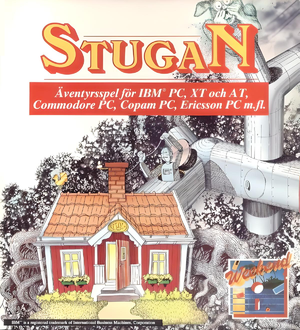Cottage: Difference between revisions
(add to museum) |
No edit summary |
||
| (One intermediate revision by the same user not shown) | |||
| Line 4: | Line 4: | ||
developer = [[Kimmo Eriksson]]<br />[[Viggo Eriksson]]<br />[[Olle Johansson]]| | developer = [[Kimmo Eriksson]]<br />[[Viggo Eriksson]]<br />[[Olle Johansson]]| | ||
publisher = [[Scandinavian PC Systems]]| | publisher = [[Scandinavian PC Systems]]| | ||
systems = [[DOS]], [[ | systems = [[DOS]], [[TOPS-10]]| | ||
release = ''' | release = '''TOPS-10'''<br />Sweden: 1978<br />'''DOS'''<br />Scandinavia: 1986| | ||
added_to_museum = Z-code: March 8, 2024| | added_to_museum = Z-code: March 8, 2024| | ||
}} | }} | ||
| Line 11: | Line 11: | ||
==Development== | ==Development== | ||
[[Viggo Eriksson]], a then ten-year-old developed the game with his then twelve-year-old brother [[Kimmo Eriksson]] and his then fourteen-year-old friend [[Olle Johansson]]. The parents of the Erikssons worked at | [[Viggo Eriksson]], a then ten-year-old developed the game with his then twelve-year-old brother [[Kimmo Eriksson]] and his then fourteen-year-old friend [[Olle Johansson]]. The parents of the Erikssons worked at Stockholm's Computer Center for Higher Education and Research (Stockholms Datamaskincentral för högre utbildning och forskning), better known as [[QZ]]. Olle Johansson's father worked for a company that was a client of QZ. Because of their parents' jobs, the trio had access to [[TOPS-10]] on the [[PDP-10]] mainframe computer known as Oden. | ||
Using the [[1975]] book ''What to Do After You Hit Return'', the brothers and their friend used [[BASIC]] to program ''Stuga'' from [[1977]] to [[1978]]. They developed the game at QZ in the evening when it was free as well as on the [[Texas Instruments]] [[Silent 700]] [[computer terminal]] in the bedroom of the parents of the Erikssons. The "Thorvalds stugråd" or "Thorvald's cottage council" [[BBS]] was set up for the developers and the QZ scientists to discuss the game and to point out bugs. | Using the [[1975]] book ''What to Do After You Hit Return'', the brothers and their friend used [[BASIC]] to program ''Stuga'' from [[1977]] to [[1978]]. They developed the game at QZ in the evening when it was free as well as on the [[Texas Instruments]] [[Silent 700]] [[computer terminal]] in the bedroom of the parents of the Erikssons. The "Thorvalds stugråd" or "Thorvald's cottage council" [[BBS]] was set up for the developers and the QZ scientists to discuss the game and to point out bugs. | ||
| Line 32: | Line 32: | ||
[[Category: ScummVM]] | [[Category: ScummVM]] | ||
[[Category: Video games]] | [[Category: Video games]] | ||
[[Category: Video games developed in | [[Category: Video games developed by QZ]] | ||
[[Category: Video games developed in Sweden]] | |||
[[Category: Video games published by Scandinavian PC Systems]] | [[Category: Video games published by Scandinavian PC Systems]] | ||
[[Category: Video games released on DOS in Scandinavia]] | [[Category: Video games released on DOS in Scandinavia]] | ||
Latest revision as of 14:28, 7 November 2024

| |
| Cottage | |
| Developer | Kimmo Eriksson Viggo Eriksson Olle Johansson |
|---|---|
| Publisher | Scandinavian PC Systems |
| Platforms | DOS, TOPS-10 |
| Released | TOPS-10 Sweden: 1978 DOS Scandinavia: 1986 |
| Added to Museum |
Z-code: March 8, 2024 |
Cottage, also known as Stuga and Stugan, was the first publicly available Swedish adventure game and was also one of the first commercial Swedish games.
Development
Viggo Eriksson, a then ten-year-old developed the game with his then twelve-year-old brother Kimmo Eriksson and his then fourteen-year-old friend Olle Johansson. The parents of the Erikssons worked at Stockholm's Computer Center for Higher Education and Research (Stockholms Datamaskincentral för högre utbildning och forskning), better known as QZ. Olle Johansson's father worked for a company that was a client of QZ. Because of their parents' jobs, the trio had access to TOPS-10 on the PDP-10 mainframe computer known as Oden.
Using the 1975 book What to Do After You Hit Return, the brothers and their friend used BASIC to program Stuga from 1977 to 1978. They developed the game at QZ in the evening when it was free as well as on the Texas Instruments Silent 700 computer terminal in the bedroom of the parents of the Erikssons. The "Thorvalds stugråd" or "Thorvald's cottage council" BBS was set up for the developers and the QZ scientists to discuss the game and to point out bugs.
DOS port
The journalist Erik Fichtelius interviewed Olle Johansson in 1984 for an article in a 1985 issue of the magazine Upp&Ner which was distributed for free on the Swedish airline Linjeflyg's flights. Johansson stated that the game would need a distributor for a home computer port of the game, which led the business software publisher Scandinavian PC Systems to opt to publish a video game when the latter discovered the game through the magazine.
The developers and a programmer provided by the publisher ported the large source code of the game to DOS. The entire game made it through the process intact except for a scene involving The Muppet Show which had to be removed due to copyright concerns. The game, slightly renamed to Stugan, was published for DOS in Scandinavia in Danish, English, Norwegian, and Swedish in 1986. The three original developers received 5 SEK for each copy with 30,000 SEK upfront.
Legacy
The game was commercially important to QZ so the three original developers were each given free accounts on Oden.
Stuga was converted from BASIC to z-code by Fredrik Ramsberg and Johan Berntsson in 2007.
The z-code version of Stuga was translated into English as Cottage by Johan Ottosson in 2009.